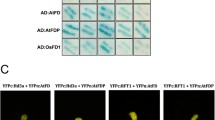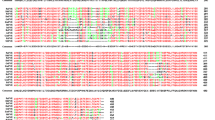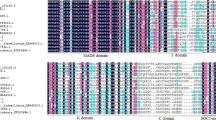Abstract
APETALA1 plays a crucial role in the transition from vegetative to reproductive phase and in floral development. In this study, to determine the effect of AP1 expression on flowering time and floral organ development, transgenic Arabidopsis and poplar overexpressing of AtAP1M3 (Arabidopsis AP1 mutant by dominant negative mutation) were generated. Transgenic Arabidopsis with e35Spro::AtAP1M3 displayed phenotypes with delayed-flowering compared to wild-type and flowers with abnormal sepals, petals and stamens. In addition, transgenic Arabidopsis plants exhibited reduced growth vigor compared to the wild-type plants. Ectopic expression of AtAP1M3 in poplar resulted in up- or down-regulation of some endogenous key flowering-related genes, including floral meristems identity gene LFY, B-class floral organ identity genes AP3 and PI, flowering pathway integrator FT1 and flower repressors TFL1 and SVP. These results suggest that AtAP1M3 regulates flowering time and floral development in plants.



Similar content being viewed by others
References
Abe M, Kobayashi Y, Yamamoto S, Daimon Y, Yamaguchi A, Ikeda Y, Ichinoki H, Notaguchi M, Goto K, Araki T (2005) FD, a bZIP protein mediating signals from the floral pathway integrator FT at the shoot apex. Science 309:1052–1056
An X, Ye M, Wang D, Wang Z, Cao G, Zheng H, Zhang Z (2011a) Ectopic expression of a poplar APETALA3-like gene in tobacco causes early flowering and fast growth. Biotechnol Lett 33:1239–1247
An XM, Wang DM, Wang ZL, Li B, Bo WH, Cao GL, Zhang ZY (2011b) Isolation of a LEAFY homolog from Populus tomentosa: expression of PtLFY in P. tomentosa floral buds and PtLFY-IR-mediated gene silencing in tobacco (Nicotiana tabacum). Plant Cell Rep 30:89–100
Baurle I, Dean C (2006) The timing of developmental transitions in plants. Cell 125:655–664
Böhlenius H, Huang T, Charbonnel-Campaa L, Brunner AM, Jansson S, Strauss SH, Nilsson O (2006) CO/FT regulatory module controls timing of flowering and seasonal growth cessation in trees. Science 312:1040–1043
Bradley D, Ratcliffe O, Vincent C, Carpenter R, Coen E (1997) Inflorescence commitment and architecture in Arabidopsis. Science 275:80–83
Brunner AM, Li J, DiFazio SP, Shevchenko O, Montgomery BE, Mohamed R, Wei H, Ma C, Elias AA, VanWormer K (2007) Genetic containment of forest plantations. Tree Genet Genomes 3:75–100
Chen Z, Yang X, Su X, Rao P, Gao K, Lei B, An X (2015) Identification and expression analysis of APETALA1 homologues in poplar. Acta Physiol Plant 37:50
Chi Y, Huang F, Liu H, Yang S, Yu D (2011) An APETALA1-like gene of soybean regulates flowering time and specifies floral organs. J Plant Physiol 168:2251–2259
Corbesier L, Vincent C, Jang S, Fornara F, Fan Q, Searle I, Giakountis A, Farrona S, Gissot L, Turnbull C, Coupland G (2007) FT protein movement contributes to long-distance signaling in floral induction of Arabidopsis. Science 316:1030–1033
Duan Y-X, Fan J, Guo W-W (2010) Regeneration and characterization of transgenic kumquat plants containing the Arabidopsis APETALA1 gene. Plant Cell Tiss Organ Cult 100:273–281
Endo T, Shimada T, Fujii H, Kobayashi Y, Araki T, Omura M (2005) Ectopic expression of an FT homolog from Citrus confers an early flowering phenotype on trifoliate orange (Poncirus trifoliata L. Raf.). Transgenic Res 14:703–712
Fernando DD, Zhang S (2006) Constitutive expression of the SAP1 gene from willow (Salix discolor) causes early flowering in Arabidopsis thaliana. Dev Genes Evol 216:19–28
Hsu CY, Liu Y, Luthe DS, Yuceer C (2006) Poplar FT2 shortens the juvenile phase and promotes seasonal flowering. Plant Cell 18:1846–1861
Hsu CY, Adams JP, Kim H, No K, Ma C, Strauss SH, Drnevich J, Vandervelde L, Ellis JD, Rice BM, Wickett N, Gunter LE, Tuskan GA, Brunner AM, Page GP, Barakat A, Carlson JE, DePamphilis CW, Luthe DS, Yuceer C (2011) FLOWERING LOCUS T duplication coordinates reproductive and vegetative growth in perennial poplar. Proc Natl Acad Sci USA 108:10756–10761
Huang H, Wang S, Jiang J, Liu G, Li H, Chen S, Xu H (2014) Overexpression of BpAP1 induces early flowering and produces dwarfism in Betula platyphylla × Betula pendula. Physiol Plantarum 151:495–506
Irish VF (2010) The flowering of Arabidopsis flower development. Plant J 61:1014–1028
Jeon JS, Jang S, Lee S, Nam J, Kim C, Lee SH, Chung YY, Kim SR, Lee YH, Cho YG, An G (2000) leafy hull sterile1 is a homeotic mutation in a rice MADS box gene affecting rice flower development. Plant Cell 12:871–884
Kardailsky I, Shukla VK, Ahn JH, Dagenais N, Christensen SK, Nguyen JT, Chory J, Harrison MJ, Weigel D (1999) Activation tagging of the floral inducer FT. Science 286:1962–1965
Kaufmann K, Wellmer F, Muino JM, Ferrier T, Wuest SE, Kumar V, Serrano-Mislata A, Madueno F, Krajewski P, Meyerowitz EM, Angenent GC, Riechmann JL (2010) Orchestration of floral initiation by APETALA1. Science 328:85–89
Kotoda N, Wada M, Kusaba S, Kano-Murakami Y, Masuda T, Soejima J (2002) Overexpression of MdMADS5, an APETALA1-like gene of apple, causes early flowering in transgenic Arabidopsis. Plant Sci 162:679–687
Kotoda N, Hayashi H, Suzuki M, Igarashi M, Hatsuyama Y, Kidou S, Igasaki T, Nishiguchi M, Yano K, Shimizu T, Takahashi S, Iwanami H, Moriya S, Abe K (2010) Molecular characterization of FLOWERING LOCUS T-like genes of apple (Malus × domestica Borkh.). Plant Cell Physiol 51:561–575
Litt A, Irish VF (2003) Duplication and diversification in the APETALA1/FRUITFULL floral homeotic gene lineage: implications for the evolution of floral development. Genetics 165:821–833
Livak KJ, Schmittgen TD (2001) Analysis of relative gene expression data using real-time quantitative PCR and the 2(−∆∆C(T)) method. Methods 25:402–408
Mandel MA, Yanofsky MF (1995) A gene triggering flower formation in Arabidopsis. Nature 377:522–524
Mohamed R, Wang C-T, Ma C, Shevchenko O, Dye SJ, Puzey JR, Etherington E, Sheng X, Meilan R, Strauss SH, Brunner AM (2010) Populus CEN/TFL1 regulates first onset of flowering, axillary meristem identity and dormancy release in Populus. Plant J 62:674–688
Pabón-Mora N, Ambrose BA, Litt A (2012) Poppy APETALA1/FRUITFULL orthologs control flowering time, branching, perianth identity, and fruit development. Plant Physiol 158:1685–1704
Peña L, Martín-Trillo M, Juárez J, Pina JA, Navarro L, Martínez-Zapater JM (2001) Constitutive expression of Arabidopsis LEAFY or APETALA1 genes in citrus reduces their generation time. Nat Biotechnol 19:263–267
Ratcliffe OJ, Amaya I, Vincent CA, Rothstein S, Carpenter R, Coen ES, Bradley DJ (1998) A common mechanism controls the life cycle and architecture of plants. Development 125:1609–1615
Ratcliffe OJ, Bradley DJ, Coen ES (1999) Separation of shoot and floral identity in Arabidopsis. Development 126:1109–1120
Rottmann WH, Meilan R, Sheppard LA, Brunner AM, Skinner JS, Ma C, Cheng S, Jouanin L, Pilate G, Strauss SH (2000) Diverse effects of overexpression of LEAFY and PTLF, a poplar (Populus) homolog of LEAFY/FLORICAULA, in transgenic poplar and Arabidopsis. Plant J 22:235–245
Shore P, Sharrocks AD (1995) The MADS-box family of transcription factors. Eur J Biochem 229:1–13
Strauss SH, Rottmann WH, Brunner AM, Sheppard LA (1995) Genetic engineering of reproductive sterility in forest trees. Mol Breed 1:5–26
Sun Y, Fan Z, Li X, Li J, Yin H (2014) The APETALA1 and FRUITFUL homologs in Camellia japonica and their roles in double flower domestication. Mol Breed 33:821–834
Wagner D, Sablowski RW, Meyerowitz EM (1999) Transcriptional activation of APETALA1 by LEAFY. Science 285:582–584
Wang C-T, Puzey J, Page G, Brunner AM (2009) Genes regulating flowering and dormancy in Populus. In: Proceedings of the 30th southern tree improvement conference, Virginia Tech, Blacksburg, VA, USA, 31 May–3 Jun 2009, p 116
Weigel D, Nilsson O (1995) A developmental switch sufficient for flower initiation in diverse plants. Nature 377:495–500
Wellmer F, Riechmann JL (2010) Gene networks controlling the initiation of flower development. Trends Genet 26:519–527
Xiang L, Li X, Qin D, Guo F, Wu C, Miao L, Sun C (2012) Functional analysis of FLOWERING LOCUS T orthologs from spring orchid (Cymbidium goeringii Rchb. f.) that regulates the vegetative to reproductive transition. Plant Physiol Biochem 58:98–105
Acknowledgments
This work was supported by the National High Technology Research and Development Program of China (2013AA102703, 2011AA100201), the National Natural Science Foundation of China (31170631, J1103516), the Changjiang Scholars and Innovative Research Team Program of China (IRT13047) and the Fundamental Research Funds for the Central Universities (BLYJ201410). We thank Steven H. Strauss and Amy M. Brunner (Oregon State University, Corvallis, OR, USA) for providing the plasmid e35Spro::AtAP1M3.
Author information
Authors and Affiliations
Corresponding author
Additional information
Zhong Chen and Meixia Ye have contributed equally to this work.
Electronic supplementary material
Below is the link to the electronic supplementary material.
11248_2015_9870_MOESM1_ESM.tif
Fig. S1 a Comparison of the deduced protein sequence of AP1 and AP1M3. The black box indicates the amino acid substitution resulting from the mutation in the gene sequence. b Schematic representation of the transformation vectors, e35Spro::AtAP1M3. LB, left border; e35Spro, enhanced cauliflower mosaic virus 35S promoter; E9term, E9 terminator; NPTII, neomycin phosphotransferase II gene; NOS-P, nopaline synthase promoter; NOS-T, nopaline synthase terminator; MAR, matrix attachment region; RB, right border. (TIFF 1281 kb)
11248_2015_9870_MOESM2_ESM.tif
Fig. S2 The process of genetic transformation of leaves of P. tomentosa with e35Spro::AtAP1M3. a Culture of poplar leaves in pre-culture medium. b Induction of multiple shoots in shoot regeneration medium from poplar leaf explants. c The production of shoots in the rooting medium. d Self-rooting shoots. e Transgenic P. tomentosa transformed with e35Spro::AtAP1M3. f Establishment of transgenic poplar in potting medium. (TIFF 2799 kb)
Rights and permissions
About this article
Cite this article
Chen, Z., Ye, M., Su, X. et al. Overexpression of AtAP1M3 regulates flowering time and floral development in Arabidopsis and effects key flowering-related genes in poplar. Transgenic Res 24, 705–715 (2015). https://doi.org/10.1007/s11248-015-9870-z
Received:
Accepted:
Published:
Issue Date:
DOI: https://doi.org/10.1007/s11248-015-9870-z




